Page 2

Links
- 57th Bomb Wing Links Page
- Some Stories and Photos from D-Day, Southern France on August 15, 1944
- Dwight Orman's 65th Fighter Squadron P-47 photos -57th Fighter Group
- Mid-Air Collision of B-25s 8U and 8P
- 12th Air Force Organization
- A Tribute to Bill Mauldin
- Museum of Aviation
- 310th Bomb Group
- 321st Bomb Group
- 57th Fighter Group
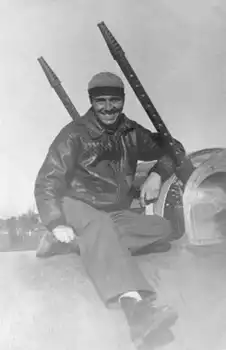
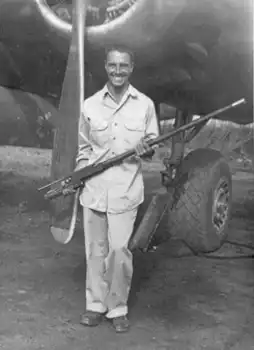
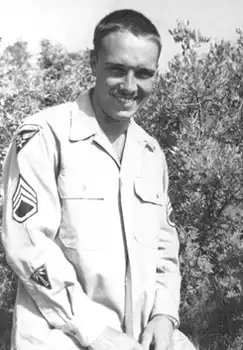
Here are several more pictures of my father, radio-gunner Quentin C. Kaiser,
taken at Alesan Air Field in Corsica during 1944. The picture on the right shows his radio
operator's patch on his lower right sleeve quite clearly.
“Early in August 1944 I flew on a mission with a slight cold and got an earache. The flight surgeon really reamed me out . I guess he was concerned with having healthy flight crews for the invasion of Southern France on August 15 but he did not tell me that. So for about two weeks starting then the 489th was on the Southern France campaign and we had no targets in Italy. We lost some planes at sur le pont d'Avignon on D_Day so I did not mind being grounded.”
“My only diary is my flight record but there may be historical details in my V-mails to Mom which are in a box in the attic. That fellow Underwood must have a detailed diary. I don't remember seeing H-models on Corsica at all. His story sounds to me like a pre-war Dare Devil Aces magazine since he went on missions where they cruised around looking for targets of opportunity. None of that in the 489th. The radiomen went to briefing with the officers and we knew exactly where we would go and when and where the German flak guns were and if we would have escorting fighters or area cover. I always felt that the Air Force was taking care of us.”

This is a nice drawing of a typical B-25J Mitchell from the 489th.
List of B-25s from the 489th
Here's a partial list compiled by Steve Pace of some of the B-25s from the 489th bombardment squadron. Planes that my father, Quentin Kaiser, flew combat missions have the number of his missions flown in parentheses. He flew a total of 65 missions.
| ATHENA | 489BS/340BG 9M | |
| AVAILABLE JONES | 489BS/340BG | |
| BET-A-MILLION | 489BS/340BG | |
| BLACK JACK II | B-25J | |
| DAISY-C | B-25J 489BS/340BG | |
| DOROTHY ANNE aka DYER'S DELIGHT | 489BS/340BG | |
| DREAMY TIME GAL | 489BS/340BG | |
| EAGER BABY | 489BS/340BG | |
| EL DIABLO | 489BS/340BG | |
| FLOOGIE JUNIOR | B-25C 489BS/340BG | |
| HAULIN' ASS | 489BS/340BG | |
| LITTLE JO | 489BS/340BG | |
| LITTLE STARDUST | (9D) 489BS/340BG | |
| MISS MARILYNN | 489BS/340BG | |
| OLD MAG DROP | 489BS/340BG | |
| OH! MOMMY! | B-25C 489BS/340BG 41-13290 | |
| SLOWTIME | 489BS/340BG | |
| TALKING FOR JO | 489BS/340BG | |
| TARBOX | 489BS/340BG | |
| WHO DAT? | 489BS/340BG | |
| 9 A | B-25J 43-35964 (3) | |
| 9 B | B-25J 43-28071 (1) | |
| 9 B | LEGAL EAGLE * | B-25J 43-35984 (2) |
| 9 C | ELLEN E. & SON | B-25D 43-3634** |
| 9 C | RUTHIE | B-25J 43-27653 (2) |
| 9 D | BRIEFING TIME | B-25J 43-27638 (2) |
| 9 E | B-25J 43-27746 | |
| 9 F | LADY BARBARA | |
| 9 F | STELLA | B-25J 43-4058 (15) |
| 9 G | BUBBIES | B-25J 43-4062 (4) |
| 9 H | BLACK JACK | B-25J 705 (1) |
| 9 J | THAT'S ALL BROTHER | B-25J 016 (3) |
| 9 K | DROOPY DOORS | |
| 9 L | MISS VIRGINIA aka OLD MAGNET PANTS | |
| 9 L | PROP-WASH | B-25J 43-27517 (1) |
| 9 M | DAMMIT! | B-25J |
| 9 M | ATHENA, DAISY(?) | B-25J 43-27655 (3) |
| 9 N | FLAK FODDER II | B-25J |
| 9 P | OOOH BROTHER! | B-25J 43-4046 (1) |
| 9 P | BLACK HAWK | B-25J 43-27489 (2) |
| 9 Q | SOLID JACKSON | |
| 9 Q | LADY ELAINE | B-25J 43-27752 (1) |
| 9 R | SNOT NOSE | B-25J 436 (1) |
| 9 S | KNOCKOUT | B-25J 43-4080 (3) |
| 9 T | MISSION COMPLETED | B-25J 045 (2) |
| 9 T | B-25J 43-27481 (1)*** | |
| 9 U | C-RATION | (4F) B-25J 855 (2) |
| 9 V | B-25J 43-27717 | |
| 9 V | MISS REBEL | B-25J 43-4016 (3) |
| 9 W | MORNING MISSION | B-25J 43-27659(3) |
| 9 X | QUEEN MARY | B-25J 43-4000 (2) |
| 9 Y | LADY LUCK | B-25J 43-27544 (5) |
| 9 Z | COMIN' OVER HUN | B-25J 43-27667 (1) |
| 9 Z | LITTLE WILLIE | |
| 9 8 | B-25C (2) **** | |
| 9 9 | B-25D 43-3638 (7)**** |
* aka SUPERDURCHSCHNITTSGESCHWIDIDIGKEITER or SPEEDY
** Being restored at the Yankee Air Museum in MI.
*** 321st BG. Possibly same plane but transferred in or out of 340th
**** Old warbird used for non-combat flights.
Thanks to Steve Pace for compiling the original list and to Bob Haney and Quentin Kaiser for updating it with some serial numbers.
Below are three more pictures from Dominique Taddei of 489th squadron personnel. These pictures were taken during the summer of 1944 at Alesani, Corsica. “In Dominique's pictures, one of them is from my squadron book and I recognize most of the fellows. There is another picture of many men and I think I recognize the one on the upper left as the mess sergeant. Most of the men in that picture are Italian prisoners of war. They did not wear hats. The ones wearing hats are American G.I.s.”

Gunners from the 489th. This picture is in the 489th Squadron Book and the men are from left to right: L.H. Vehige, R. Stewart, P.V. Bourque, J.R. Vincent, R.L. Eikhoff, E.J. Cooper and V.W. Malone.
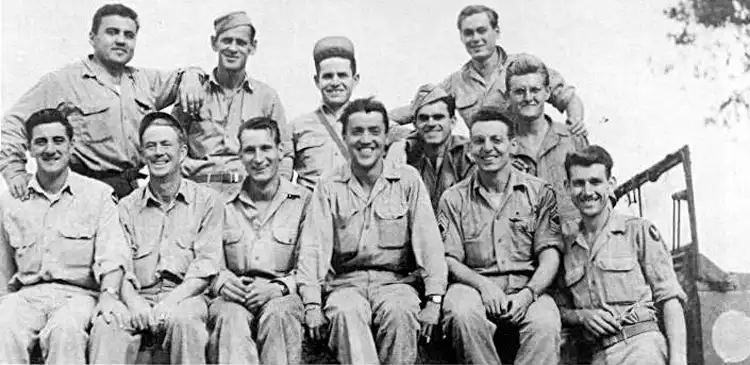
This picture, also in the 489th Squadron Book, is labeled "Communications Group."
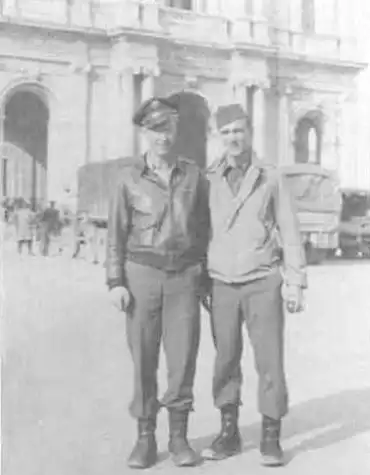
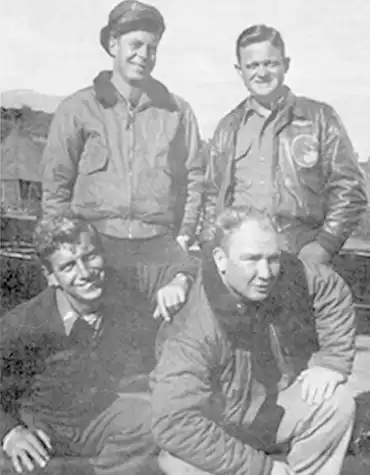
Left picture: Italy, March 5, 1944, two 489th men on leave- Billy K. Walker from Samnorwood, Texas
and Joseph J. Moore who was born in Paterson, New Jersey and grew up in Lakewood, Ohio. Joe Moore's note on the
back of this photo: "Billy K. Walker with me- boots and all. The occasion-
B.K.'s birthday- what a time we had!" Billy K. Walker was killed on May 13,
1944 at Alesan Air Field, Corsica during the surprise German air raid.
Joe Moore became the
crew chief of a brand new B-25J with tail letters 9D after the previous 9D was damaged in
the German air raid. Joe named the new 9D Briefing Time. His crew maintained
Briefing Time so well that it never missed a single one of its 126 missions. Today,
the Mid Atlantic Air Museum maintains a B-25J as
Briefing Time 9D with Joe Moore's name on it, just like the original. Joe Moore passed
away in 1983. Photo contributed by the family of Joseph J. Moore.
Right picture: Corsica, 1944, four 489th men in a relaxing pose. Back row, Bill Reinhold of
New Hampshire. Bill was the local representative for the 1983 reunion. Millard Harper of
Dallas. Millard never misses a 57th reunion. Front row, Bob Martin of Portland, Oregon.
Bob was killed in a plane accident after returning to the states. Al Borden of Indianapolis,
Indiana. Al died in 1983. Photograph contributed by George Bleimes of Gahanna, Ohio.

This 489th B-25D is being restored at the Yankee Air Museum complete with a "greenhouse" nose acquired from a B-25 graveyard in southern California. To my knowledge, this plane is the only remaining combat veteran B-25 from the 489th bombardment squadron in Corsica. Now known as Yankee Warrior, this plane flew the missions shown below as Ellen E. & Son 9C 634 from Alesan Air Field, Corsica in 1944:
| April 19, 1944 | Piomobino, Storage Tank, Italy | P- AA Ammann |
| April 23, 1944 | Orvieto RR Bridge, Italy | P- JG Connolly |
| April 24, 1944 | NW Orvieto RR bridge, Italy | P- HH Spear |
| April 25, 1944 | Ficulle S RR bridge, | Standby |
| April 28, 1944 | Orvieto SE RR bridge, Italy | P- Lieblueh |
| May 1, 1944 | Albinie RR bridge, Italy | P- AA Ammann |
| May 2, 1944 | Orvieto N RR bridge, Italy | P- MacLellan |
| May 3, 1944 | Todi NNW RR bridge, Italy | P- WR Witty |
| May 4, 1944 | M/Y Costiglione, Fiorentino, Italy | P- HH Spear |
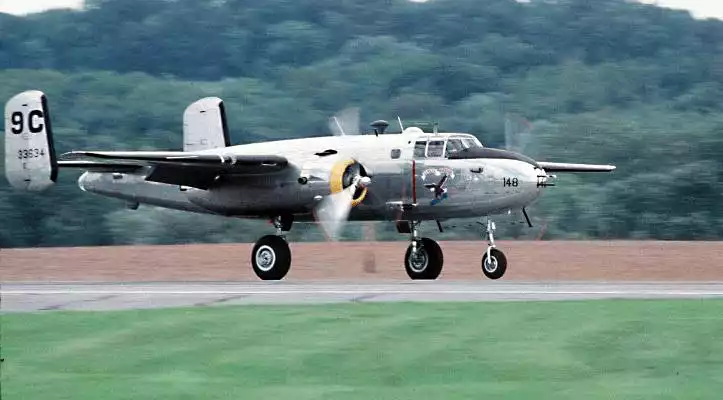
I found this picture on the net of the same original combat veteran B-25D #43-3634 with its 9C tail letters evident.
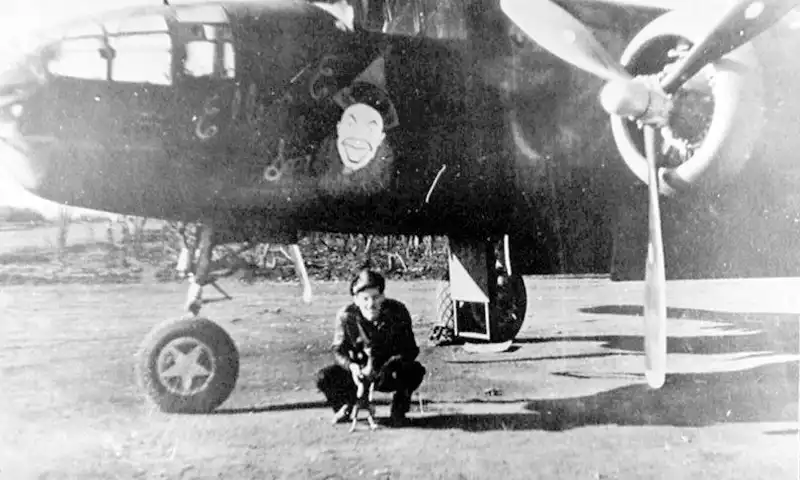
Here's what the original nose art for B-25D 9C #43-3634 'Ellen E. and Son' looked like when it was maintained by crew chief Ezra Baer in early 1944.

That sure looks like Mose "Alesan" at the piano to me. I love that old f-hole guitar. I found this comment from the biography of B-25J pilot George W. Marsh of the 489th bombardment squadron concerning his plane's excursion to Corsica in February, 1945, extremely interesting:
“I flew by way of South America and on to Ascension Island. The day before we arrived the supply ship was torpedoed and we were grounded by a dust storm in the Sierra Desert. Food and supplies were very short. We then flew on to Africa. Between Marrakech and Tunis my radio operator tuned into Berlin Radio and heard Axis Sally broadcast a welcome to our crew. She listed our aircraft serial number and destination and for each man aboard she listed name, rank, serial number, home address and wife's name. She also told us the Group and Squadron we would be assigned to, which even we didn't know. We were indeed assigned to the 340 Bomb Group, 489th Squadron, 12th Air Force, just like she said.”
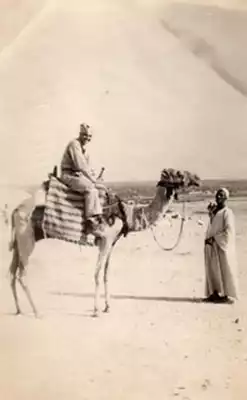

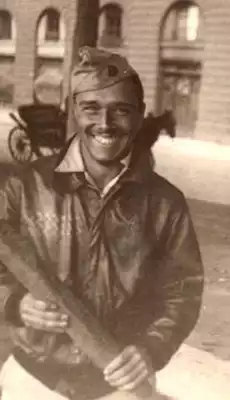
Left picture: "All I did was sit on the camel to have my picture taken.
The driver makes the camel kneel down squat so you can get on. They look very awkward and
slow doing this. The driver collected a fee for doing this but he kept the camel's rump
facing the camera. There was a second fee to turn the camel around so you could take the
picture."
Center picture: "I can't see for sure but
this looks like Bill Devine standing on a corner in Lyon. He took my picture with the
bread at about the same time.
Right picture:"This is real French bread. This picture was taken during my one day in France when Devine and I
flew up to Lyon to deliver some bigwigs. I am not sure but I think we shared the bread for
our supper that night because there were no restaurants open."
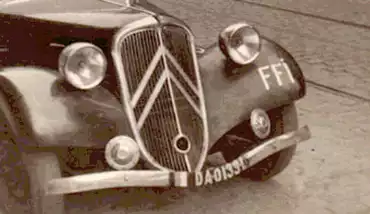
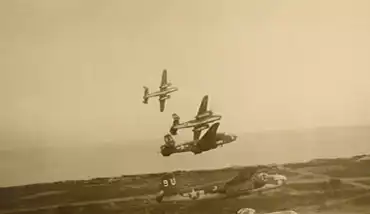
“Returning from a mission each box of six aircraft formed an echelon (diagonal formation) and flew low over the field. Then they formed a large circle and landed one by one. I took this picture from the fourth position which was the leading position in the second group of three aircraft.” That's a nice view of C-Ration 9U in front.
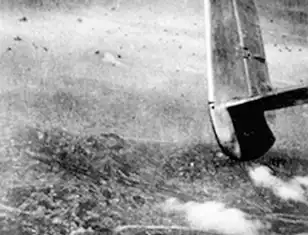
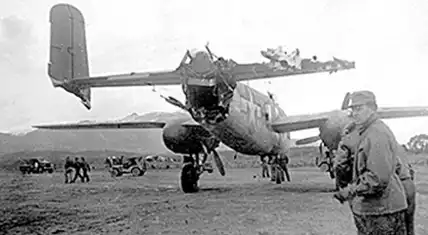
Left picture: "The picture of all the flak is from a paper negative that
Rich sent and reversed. That picture is in the squadron book but it is very small. I don't
know anything about it except I got it just before leaving Corsica."
Right picture: "The picture of the B-25 with the chewed up tail is on the
same page. They are listed as war damage but as I remember it the enemy did not chew up the
tail. That was the result of one B-25 running into another while in formation. I seem to
remember going down to look at the damage. The picture in the squadron book is not identical
but similar." Dominique Taddei supplied the following information about
the collision: "...this photo has been taken the 21st of January 1945 at
Alesani. This B-25J was the "8P" 43-27657 with pilot, 2nd Lt. W.B. Pelton. After the bombing
of San Michele, the flak started to fire but nobody was hit. Changing the heading to join
Corsica, a strong blast of wind unbalanced the "8U" 43-4064 with pilot, 1st Lt. W.Y. Simpson.
The 8U collided with the 8P tail and killed the tail gunner S/Sgt. Aubrey B. Porter. The 8U
came down in a spin and crashed with all the crew members (KIA). The 8P landed safely at
Alesani with such tail. 8U crew: Pilot, 1st Lt. William Y. Simpson/ Copilot, 2nd Lt.
Frederick C. Greenig/ S/Sgt. James C. Rice/ Sgt. Doyles G. Shipley/ Sgt. Robert J. Jackson/
Cpl. Fred B. Hicks. 8P crew: Pilot, 2nd Lt. W.B. Pelton/ Cap., F/O H.K. Shackelford/ S/Sgt.
A.J.Bertagna/ S/Sgt. R.C. Garner/ Cpl. H. Lisby and S/Sgt. A.B. Porter (MIA). (The crew
lists give only the pilot positions nothing about the gunners) I have only the names.
Unfortunately for 1st Lt. Pelton, the 16th of March 1945, his B-25 "8H" ditched at 4 miles
after the take-off, the two engines stopped at the same time, the plane blown up in touching
the water. Only the body of the radio-gunner was found and buried at the cemetery of Bastia-
S/Sgt. Lawrence W. Kahl."

Here's another look at B-25 8P which fortunately made it back to base at Alesan Air Field, Corsica after it's mid-air collision with B-25 8U, which unfortunately did not. Photograph courtesy of Dominique Taddei. I'm not sure but I think this plane must be a memorial to the crew (see above) of B-25J 8U which perished in the mid-air collision with B-25 8P on January 21, 1945.
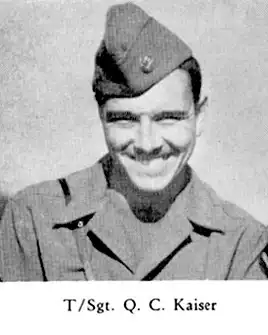
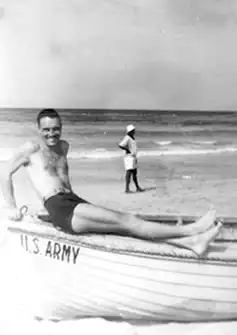
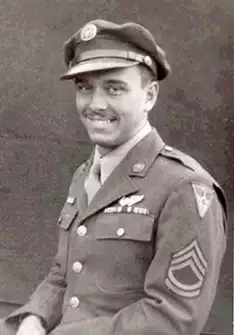
Left picture: This is my dad's picture as it appears in the 489th squadron book. Center picture: "In this pose I am on the army's recreational beach in Alexandria, Egypt." (Baywatch 1944?) Right picture: "Here I am in a borrowed hat and sporting my "Donny" smile." My dad still has some of these same medals and decorations as seen in this picture.

"This is the last picture of me as a civilian when your Mom (to be, Evelyn Burkland) and my Dad (Philip Kaiser) came down to see me off. We are in lower Manhatten at the "Hudson Tubes" that was a subway which ran under the Hudson River and took you to New Jersey to get on a train. All the railroads did not have stations on Manhatten Island."

"I thought about this picture of the ring sight long before I finally took this one. I consider it art in warfare. Some of the guns later on had optical sights which looked like a box on top of the gun. The "ring" in the optical sight seemed to be focused at infinity so you saw the target and ring equally sharp. Because the gunner was so close to the metal sight the ring was out of focus and fuzzy if you were focused on the target." Photograph by Quentin Kaiser.


Left picture: Flak hole. "I am not sure but I think this is the hole made by the flak that hit my ammunition container." (Notes for mission #17: 'July 15, 1944, 9J, Ferrara, Italy. Hit in neck. Over 50 holes. Hit northern approach to R.R. bridge.') "I have the piece of flak and several of the exploded 50s. If it is that hole, that was the day I grabbed the red handle on the rear hatch. There is more to this, too." Right picture: Flak suit. "You can see the red tag in the front which you pull to open the snap fasteners at the shoulders which I did in the above instance. The normal draft was clearing the dense smoke from the cabin so I started to replace the flak suit when I saw that the falling flak suit had disconnected my microphone and headset. I connected the headset first and I could hear the pilot calling me and then telling Carter to give me assistance. Carter was loathe to enter the smoked-in area and just about then I had the microphone connected and could respond. I think I have already mentioned reaming Carter out for not coming to my aid." Note the 11 bombs painted on the side of Stella which are not in the picture of my dad's crew beside Stella that appears in the 489th squadron book.
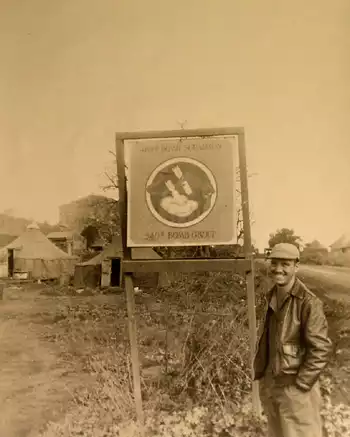
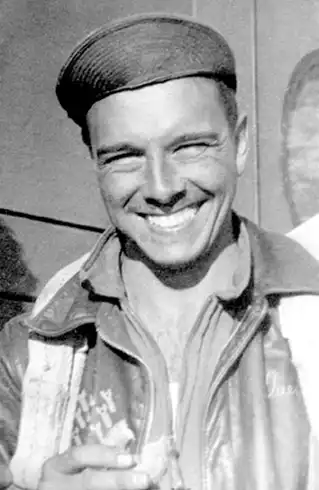
“It was always lovely to get your two feet back on the ground. Nose art usually showed the number of missions and we did this with our A-2 jackets as well as you can see in this picture. Airplane dope was at hand and we used that but it became brittle and flaked off and that was that. At one time I also had a B-25J on the back of my jacket but that met the same fate.”

This is an aerial view of the 340th bombardment group's base and airfield at Alesani, Corsica, home for the 489th bombardment squadron. Photograph from Mr. Durley Bratton & Dominique Taddei.
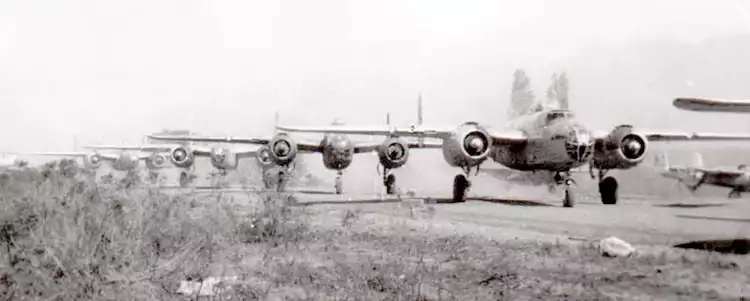
"In the taxiing picture, we did that on every mission. In the beginning we took off one a/c at a time but later on we took off two at a time but they were staggered slightly I guess to minimize the prop wash of one interfering with the other. I am not sure but I seem to remember that the radioman and tail gunner would raise the radioman's seat and they both would sit with their backs against the bomb bay wall in case there would be a crash on take-off. The pilots did not want the tail gunner in the tail on take off. I guess that made the plane tail heavy."
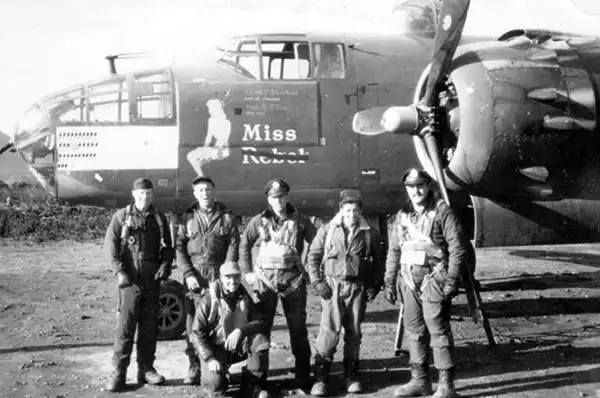
Quentin Kaiser is kneeling. "I was surprised to find this picture along with another professionally done one of the Stella crew. It is not in the SQ BK but the Stella one is. In the SQ BK Miss Rebel is said to be 9V and I flew in 9V on January 30, 1945. This is mission #63. My notes say 'chaff in last element'. The odd thing is that I recognized the short fellow on the right as another radio-gunner and I looked him up. He is a T/SGT, so a radio-gunner, and his name is Constantine which I remember. Two radiomen is rare so I figure this is the chaff mission where I flew top turret and, if this is the case, it is the mission which really made me war-weary. Chaff, or 'window' is an eight-inch piece of tin foil with paper backing and its length is made to be 1/2 wavelength at the frequency of the enemy radar. We would send in three chaff ships over the target and the chaff they dropped would look like a lot of noise to the radar operators so the bombing a/c coming
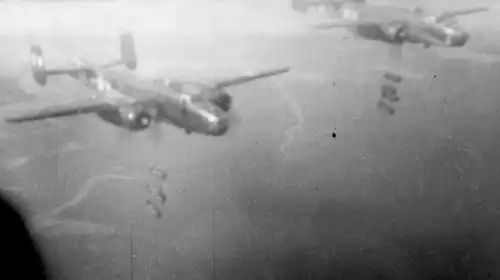 along afterward could not be seen. I think the first box of six bombers also
dropped chaff to protect the later boxes. Our experience was that the Germans aimed at the
bombing a/c so a chaff mission was a milkrun. If this is the day I recall it is the
one where the Germans changed their tactics and aimed at the chaff ships since they are not
protected. It was the longest I had ever been in flak. When flying top turret you kept the
guns pointed aft because a cold breeze came in through the gun slits if you swung the turret
forward. Also, if being exposed to flak, you knew you did not have to worry about enemy
fighters. When the bombardment got heavy I reached down and unlatched the catch on the
bicycle seat used in the turret and I snuggled up to the stainless steel cylinder used to
support the turret. It looked like good armor to me. I
along afterward could not be seen. I think the first box of six bombers also
dropped chaff to protect the later boxes. Our experience was that the Germans aimed at the
bombing a/c so a chaff mission was a milkrun. If this is the day I recall it is the
one where the Germans changed their tactics and aimed at the chaff ships since they are not
protected. It was the longest I had ever been in flak. When flying top turret you kept the
guns pointed aft because a cold breeze came in through the gun slits if you swung the turret
forward. Also, if being exposed to flak, you knew you did not have to worry about enemy
fighters. When the bombardment got heavy I reached down and unlatched the catch on the
bicycle seat used in the turret and I snuggled up to the stainless steel cylinder used to
support the turret. It looked like good armor to me. I

I really felt war-weary because I found myself actually shaking. This was contrary to the two pilots seated right in front of me who seemed to be enjoying things. Not me! I also recognize the fellow behind me who I think was a tail gunner but I did not look him up. I seem to remember that Voss was one of the pilots but I don't recognize him in the photo. I am not sure about the bomb pictures but they all look like 1000-pounders and four was all that could be carried. There were two on each side but staggered vertically because the B-25 could not carry two side-by side. The bombs were too fat. We also had armor-piercing 1000-pounders which had solid steel noses and were smaller in diameter. We could carry these side-by side and could carry six of them. They were used against concrete bridges but none are pictured."


"On the evening after a mission they always published the results on the bulletin board at the operations tent. They always scored how close we were to the target. Even if we missed the target we could get a good score" (The probability of a direct hit from 10,000 feet was not great even with the Norden bombsight.)

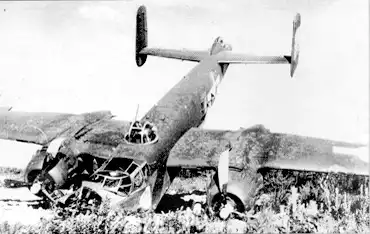
My father flew 3 missions in 9V. Fortunately, this wasn't one of them. This 9V was called 'That's All Brother.' Dominique Taddei explains: "No one was hurt in this crash. Harold Lynch told me that he flew on this training bombing flight above the Island of Capraia, North East of Corsica, with Lt Scott Herrin as Pilot, the evening before they washed down with scotch and aqua vita. They confirmed that she was the same plane."
My dad's missions in 9V were on December 27, 1944 (mission #50, Calliano), December 28, 1944 (mission #51, Bovornica, Yugoslavia) and on January 30, 1945 (mission #63, Lavis, in Miss Rebel, scroll up a ways for picture). Each of these missions were in serial #016. He did return to Corsica from four days of leave in Rome on September 15, 1944 in the crashed 9V shown above with the serial #717. Therefore, I suppose the crash occurred between September 15th and December 27th, 1944. That looks like a good view (in the left picture behind the plane) of the dense Corsican underbrush (or maybe that's Underwood back there), also known as the "Maquis" from which the French Underground derived its nickname. (Photographs from Dominique Taddei).